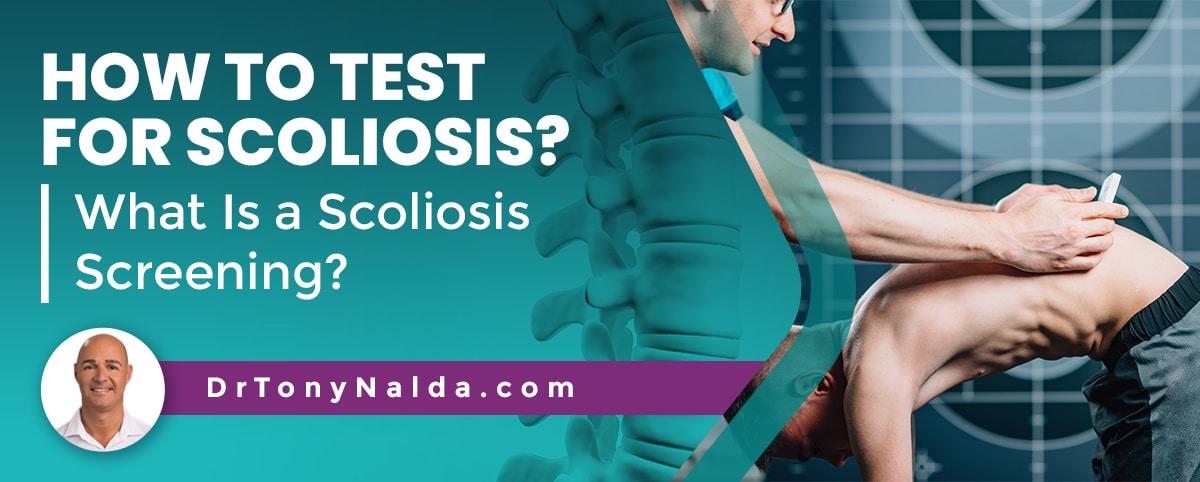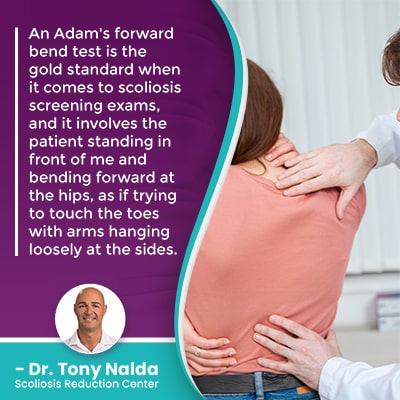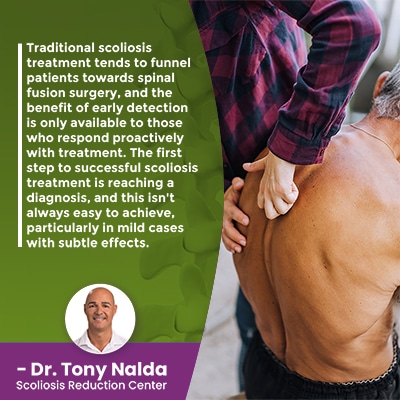How To Test For Scoliosis? What Is a Scoliosis Screening?

Once scoliosis is diagnosed, patients have an important decision to make: how to treat the condition. Screening for scoliosis can help achieve early detection, which doesn't guarantee treatment success, but is associated with it.
While there are never treatment guarantees, with early detection and a proactive treatment plan, there are fewer limits to what can be achieved. Through a scoliosis screening test known as the Adam's forward bend test, condition indicators can be found, and the need for further testing can be determined.
There was a time when mandatory scoliosis screening was conducted in schools across the United States, but that has changed, shifting the onus of early detection onto the shoulders of parents and patients themselves.
Table of Contents
Why is Early Detection Important?
Patients recently diagnosed with scoliosis have developed an unnatural sideways curvature of the spine that also rotates, making it a 3-dimensional condition.
Early detection doesn't guarantee any type of treatment success, but it is associated with it because as a progressive condition, the best time to start scoliosis treatment is always now.
Early detection of scoliosis means it's diagnosed early in the condition's progressive line, and these are the condition's severity levels: mild to moderate and severe to very-severe scoliosis.
Condition severity is determined by a measurement known as Cobb angle, and the higher a patient's Cobb angle, the more severe the condition, and the more likely it is that its effects are going to be noticeable:
- Mild scoliosis: Cobb angle measurement of between 10 and 25 degrees
- Moderate scoliosis: Cobb angle measurement of between 25 and 40 degrees
- Severe scoliosis: Cobb angle measurement of 40+ degrees
- Very-severe scoliosis: Cobb angle measurement of 80+ degrees
As a progressive condition whose nature is to get worse over time, where a scoliosis is at the time of diagnosis isn't indicative of where it will stay, and that's why early detection is important, and with the Scoliosis Research Society's current estimates at close to seven million people living with scoliosis in the United States alone, it's highly-prevalent: another reason early detection is important.
Early detection is also important because scoliosis only gets more complex to treat the more it progresses, so the earlier a condition is diagnosed in its progressive line, the milder it is, and the simpler it can be to treat.
So let's now talk about what scoliosis screening involves.
Scoliosis Screening
As mentioned, it's now the role of parents, and patients themselves, to be educated on the subtle indicators of scoliosis, and it's also important to understand that there are different types of scoliosis a person can develop.
Part of diagnosing scoliosis involves further classifying conditions based on key patient/condition variables, and this includes patient age, curvature location, condition severity, and condition type.
 Type is determined by causation, and the most prevalent type of scoliosis to affect both children and adults is idiopathic scoliosis (no known cause), and this accounts for approximately 80 percent of known diagnosed scoliosis cases, and the remaining 20 percent are associated with known causes: neuromuscular scoliosis, degenerative scoliosis, and congenital scoliosis.
Type is determined by causation, and the most prevalent type of scoliosis to affect both children and adults is idiopathic scoliosis (no known cause), and this accounts for approximately 80 percent of known diagnosed scoliosis cases, and the remaining 20 percent are associated with known causes: neuromuscular scoliosis, degenerative scoliosis, and congenital scoliosis.
So screening can show up indicators for different types of scoliosis, and the most prevalent type of scoliosis overall is adolescent idiopathic scoliosis, diagnosed between the ages of 10 and 18.
The most common type of screening exam is known as the Adam's forward bend test and this is combined with a comprehensive physical examination that also involves taking the patient's medical/family history.
Although scoliosis isn't considered a genetic condition, it is familial, meaning if one member of a family has been diagnosed, it is a risk factor for others in the family to be diagnosed.
In the condition's most-prevalent type, adolescent idiopathic scoliosis, this age group is the most at risk for rapid-phase progression because growth is the trigger for progression, and the stage of puberty is characterized by rapid and unpredictable growth spurts; so early detection is particularly important when treating scoliosis in children who have not yet reached skeletal maturity.
The Adam's Forward Bend Test
So if a concerned parent brings in their adolescent for a scoliosis screening exam, it starts with discussing any signs, symptoms, and whether or not there is a family history.
I also observe a patient's posture and gait; I can tell a lot about spinal health by body positioning and gait.
An Adam's forward bend test is the gold standard when it comes to scoliosis screening exams, and it involves the patient standing in front of me and bending forward at the hips, as if trying to touch the toes with arms hanging loosely at the sides.
In this position, the spine is at its most visible, as are any postural asymmetries related to the condition.
In children, the main condition-effect is postural deviation caused by how the condition's uneven forces disrupt the body's overall symmetry, and these can include:
- Uneven shoulders
- Uneven shoulder blades (one shoulder blade higher than the other)
- The development of a rib arch
- An uneven waistline
- Uneven hips
- Arms and legs that appear to hang at different lengths
Additional signs of scoliosis in children for parents to look out for include ill-fitting clothing that used to fit, and changes to balance, coordination, and gait.
When combined with the use of a scoliometer, I can measure a misaligned spine and determine a patient's angle of trunk rotation (ATR); a rib cage arch is the most common indicator of the condition's rotational component, and rib cage arches are also the most visible in this position.
So if a screening exam finds condition indicators, this warrants the need for further testing, and an X-ray can be ordered to truly see what's happening in and around the spine, to determine a patient's Cobb angle measurement, and to reach an official diagnosis of scoliosis.
So now that we've determined why testing for scoliosis is important, let's talk about what happens after scoliosis screening has led to an official diagnosis of scoliosis.
Treating Scoliosis
 After a diagnosis of scoliosis has been reached, the most important decision to be made is how to treat it moving forward.
After a diagnosis of scoliosis has been reached, the most important decision to be made is how to treat it moving forward.
Scoliosis is incurable, but it can be highly treatable, and treatment success is more likely if conditions are detected early and responded to with proactive treatment.
Not all scoliosis treatment options are proactive in nature; in fact, traditional scoliosis treatment is reactive because it doesn't have a strategy for treating scoliosis while mild, only when/if patients progress into the severe classification; little is done beforehand to prevent progression.
Traditional scoliosis treatment tends to funnel patients towards spinal fusion surgery, and the benefit of early detection is only available to those who respond proactively with treatment.
Fortunately, for those choosing to forgo a surgical recommendation, there is conservative treatment that offers patients a proactive and non-surgical treatment response.
Here at the Scoliosis Reduction Center, I want to be proactive with treatment by starting it as close to the time of diagnosis as possible, when conditions are likely to be at their mildest and most responsive, and I want to work towards preventing progression, increasing condition effects, and the need for invasive surgical treatment in the future.
I combine condition-specific chiropractic care, physical therapy and scoliosis-specific exercises (SSEs), corrective bracing, and rehabilitation to impact conditions on every level.
Conclusion
Scoliosis is a complex 3-dimensional progressive spinal condition, and abnormal spinal curvatures that are progressive should be taken seriously, particularly in children as growth spurts are the condition's progressive trigger.
Scoliosis progressing means the size of the unnatural spinal curve is increasing, as are the condition's uneven forces, and their effects.
Scoliosis home screening can involve awareness of the condition's early indicators such as uneven shoulders and hips, but only an official screening examination conducted by a medical professional is a reliable indicator that further testing is needed.
If a screening exam finds condition indicators, an X-ray can confirm that scoliosis has developed and can also help classify conditions based on key details.
Testing for scoliosis is important because early detection can increase the likelihood of reaching treatment success, and particularly when it comes to treating children scoliosis, because growth is the condition's progressive trigger, when treatment is started can be crucial.
An Adam's forward bend test, when a patient leans forward at the hips at a 90-degree angle, is the best way to view a curved spine, and observing a patient's spine and trunk while they lean forward is the best position for detecting rotational and postural asymmetries.
Scoliosis screenings are important because they can put patients on the road to early detection, and proactive conservative scoliosis treatments can impact conditions on multiple levels.
Dr. Tony Nalda
DOCTOR OF CHIROPRACTIC
After receiving an undergraduate degree in psychology and his Doctorate of Chiropractic from Life University, Dr. Nalda settled in Celebration, Florida and proceeded to build one of Central Florida’s most successful chiropractic clinics.
His experience with patients suffering from scoliosis, and the confusion and frustration they faced, led him to seek a specialty in scoliosis care. In 2006 he completed his Intensive Care Certification from CLEAR Institute, a leading scoliosis educational and certification center.
About Dr. Tony Nalda
 Ready to explore scoliosis treatment? Contact Us Now
Ready to explore scoliosis treatment? Contact Us Now





